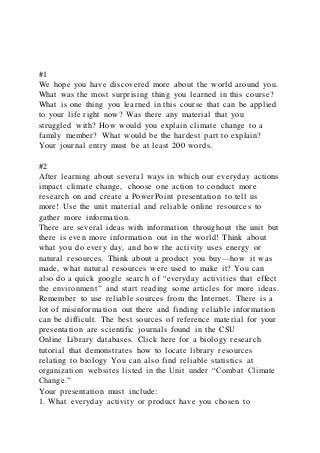
#1We hope you have discovered more about the world around you.
- 1. #1 We hope you have discovered more about the world around you. What was the most surprising thing you learned in this course? What is one thing you learned in this course that can be applied to your life right now? Was there any material that you struggled with? How would you explain climate change to a family member? What would be the hardest part to explain? Your journal entry must be at least 200 words. #2 After learning about several ways in which our everyday actions impact climate change, choose one action to conduct more research on and create a PowerPoint presentation to tell us more! Use the unit material and reliable online resources to gather more information. There are several ideas with information throughout the unit but there is even more information out in the world! Think about what you do every day, and how the activity uses energy or natural resources. Think about a product you buy—how it was made, what natural resources were used to make it? You can also do a quick google search of “everyday activities that effect the environment” and start reading some articles for more ideas. Remember to use reliable sources from the Internet. There is a lot of misinformation out there and finding reliable information can be difficult. The best sources of reference material for your presentation are scientific journals found in the CSU Online Library databases. Click here for a biology research tutorial that demonstrates how to locate library resources relating to biology You can also find reliable statistics at organization websites listed in the Unit under “Combat Climate Change.” Your presentation must include: 1. What everyday activity or product have you chosen to
- 2. present? Why did you choose this activity or product? Why is it important? 2. Connect the activity/product to its impact on the environment and climate change. How does doing the activity or making the product use natural resources, disrupt habitat, impact wildlife or other effects on the environment? 3. Report data and statistics, with references, on how this activity/product effects the environment. 4. What can people do to decrease the activity/product’s impact on the environment? Be sure to follow the formatting and guidelines provided below: · Include at least three visual aids. · Include three reliable references, and at least one source must come from the CSU Online Library. · Use bulleted information on slides (five lines or fewer). · Include substantial and detailed speaker's notes that include what you would say in an actual presentation. The speaker's notes should also reflect the depth of your research. · Include a separate title slide and separate reference slide. · Use an appropriate font and background. · Include at least 11 slides, but not more than 15 slides (not counting your title slide and reference slide). · Use correct APA format for references and citations, and use correct grammar and spelling. · Upload the presentation as a .ppt or .pptx file. School of Computer & Information Sciences ITS-631- Operational Excellence Chapter 10 – Information Technology and Organizational Learning
- 3. Introduction Digital transformation is defined as the changes associated with the applications of digital technology within every of human society The challenge becomes how to get IT more engaged with the buyer community Review the six approaches for IT to be more engaged: Sales/Marketing Third-party market analysis/reporting Predictive analytics Consumer support departments Surveys Focus groups Requirements without Users and Input Technology generates change called digital disruption Challenge in disruption is the inability to predict the consumers wants and needs Graphic depiction of the relationship between technology advancements and market needs (figure 10.2) Porter’s Five Forces Competitors New Entrants Substitutes Buyers
- 4. Suppliers Langer’s Driver/ Supporter model Figure 10.6 depicts the life cycle of any application or product Organizational Learning and the S-curve When designing a new application or system, the status of that product’ s S-curve should be carefully correlated to the source of the requirements. S-curve analysis (Table 10.3) IT Leader in Digital Transformation Era The IT leader must become more innovative. Quality requirements will be even more complex Dynamic interaction among users and business teams will require the creation of multiple layers of communities of practice. Application analysis, design, and development must be treated and managed as a living process; that is, it never ends until the product is obsolete (supporter end). So, products must continually develop to maturity.
- 5. Organizations should never outsource a driver technology until it reaches supporter status. How Technology Disrupts Firms and Industries The world economy is transforming rapidly from an analogue to a digital-based technology-driven society. This transformation requires businesses to move from a transactional relationship to one that that is “interactional” Dynamism and Digital Disruption how to can anticipate the unexpected threats brought on by technological advances that can devastate their business. There are typically two disruption factors: A new approach to providing products and services to the consumer. A strategy not previously feasible, now made possible using new technological capabilities. Critical Components of Digital Organizations Unified digital platform Solution delivery Analytics capabilities
- 6. Business and IT integration Assimilating Digital Technology Operationally and Culturally Organizations must create a new architecture when implementing digital technologies. Companies must recognize that speed and comfort of service can be more important than just the cost. Empower workforce to try new ideas without over controls. Allow employees and customer to have choice of devices. Organizations who force staff to adhere to strict processes and support structures are exposed to digital disruption. References Langer, A. M. (2018). Information Technology and Organizational Learning. 3rd edition. Taylor & Francis Group, LLC. ISBN: 978-1-138-23858-9